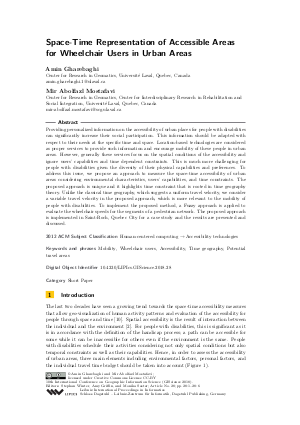Space-Time Representation of Accessible Areas for Wheelchair Users in Urban Areas (Short Paper)
Authors Amin Gharebaghi, Mir Abolfazl Mostafavi
-
Part of:
Volume:
10th International Conference on Geographic Information Science (GIScience 2018)
Part of: Series: Leibniz International Proceedings in Informatics (LIPIcs)
Part of: Conference: International Conference on Geographic Information Science (GIScience) - License:
 Creative Commons Attribution 3.0 Unported license
Creative Commons Attribution 3.0 Unported license
- Publication Date: 2018-08-02
File

PDF
LIPIcs.GISCIENCE.2018.28.pdf
- Filesize: 376 kB
- 6 pages
Document Identifiers
Subject Classification
ACM Subject Classification
- Human-centered computing → Accessibility technologies
Keywords
- Mobility
- Wheelchair users
- Accessibility
- Time geography
- Potential travel areas
Metrics
- Access Statistics
-
Total Accesses (updated on a weekly basis)
0Document
0Metadata
Abstract
Providing personalized information on the accessibility of urban places for people with disabilities can significantly increase their social participation. This information should be adapted with respect to their needs at the specific time and space. Location-based technologies are considered as proper services to provide such information and encourage mobility of these people in urban areas. However, generally these services focus on the spatial conditions of the accessibility and ignore users' capabilities and time dependent constraints. This is much more challenging for people with disabilities given the diversity of their physical capabilities and preferences. To address this issue, we propose an approach to measure the space-time accessibility of urban areas considering environmental characteristics, users' capabilities, and time constraints. The proposed approach is unique and it highlights time constraint that is rooted in time geography theory. Unlike the classical time geography, which suggests a uniform travel velocity, we consider a variable travel velocity in the proposed approach, which is more relevant to the mobility of people with disabilities. To implement the proposed method, a Fuzzy approach is applied to evaluate the wheelchair speeds for the segments of a pedestrian network. The proposed approach is implemented in Saint-Roch, Quebec City for a case study and the results are presented and discussed.
Cite As Get BibTex
Amin Gharebaghi and Mir Abolfazl Mostafavi. Space-Time Representation of Accessible Areas for Wheelchair Users in Urban Areas (Short Paper). In 10th International Conference on Geographic Information Science (GIScience 2018). Leibniz International Proceedings in Informatics (LIPIcs), Volume 114, pp. 28:1-28:6, Schloss Dagstuhl – Leibniz-Zentrum für Informatik (2018)
https://doi.org/10.4230/LIPIcs.GISCIENCE.2018.28
BibTex
@InProceedings{gharebaghi_et_al:LIPIcs.GISCIENCE.2018.28,
author = {Gharebaghi, Amin and Mostafavi, Mir Abolfazl},
title = {{Space-Time Representation of Accessible Areas for Wheelchair Users in Urban Areas}},
booktitle = {10th International Conference on Geographic Information Science (GIScience 2018)},
pages = {28:1--28:6},
series = {Leibniz International Proceedings in Informatics (LIPIcs)},
ISBN = {978-3-95977-083-5},
ISSN = {1868-8969},
year = {2018},
volume = {114},
editor = {Winter, Stephan and Griffin, Amy and Sester, Monika},
publisher = {Schloss Dagstuhl -- Leibniz-Zentrum f{\"u}r Informatik},
address = {Dagstuhl, Germany},
URL = {https://drops.dagstuhl.de/entities/document/10.4230/LIPIcs.GISCIENCE.2018.28},
URN = {urn:nbn:de:0030-drops-93562},
doi = {10.4230/LIPIcs.GISCIENCE.2018.28},
annote = {Keywords: Mobility, Wheelchair users, Accessibility, Time geography, Potential travel areas}
}
Author Details
References
- Amin Gharebaghi, Mir-Abolfazl Mostafavi, Seyed Chavoshi, Geoffrey Edwards, and Patrick Fougeyrollas. The Role of Social Factors in the Accessibility of Urban Areas for People with Motor Disabilities. ISPRS International Journal of Geo-Information, 7(4):131, 2018. URL: http://dx.doi.org/10.3390/ijgi7040131.
-
Amin Gharebaghi, Mir-Abolfazl Mostafavi, Geoffrey Edwards, Patrick Fougeyrollas, Patrick Morales-Coayla, François Routhier, Jean Leblond, and Luc Noreau. A Confidence-Based Approach for the Assessment of Accessibility of Pedestrian Network for Manual Wheelchair Users. In International Cartographic Conference, pages 463-477. Springer, 2017.

- Torsten Hägerstrand. What about people in Regional Science? In Papers of the Regional Science Association, volume 24, pages 6-21, 1970. URL: http://dx.doi.org/10.1007/BF01936872.
-
M D Hendricks, M J Egenhofer, and K Hornsby. Structuring a wayfinder’s dynamic space-time environment. Conference on Spatial Information Theory, pages 75-92, 2003.

- Mei-Po Kwan. Space-Time and Integral Measures of Individual Accessibility: A Comparative Analysis Using a Point-based Framework, 2010. URL: http://dx.doi.org/10.1111/j.1538-4632.1998.tb00396.x.
-
Mei-Po Kwan and Joe Weber. Individual accessibility revisted: implications for geographical analysis in the twenty-first century. Geographical Analysis, 35(4):341-353, 2003.

- Jinhyung Lee and Harvey J. Miller. Measuring the impacts of new public transit services on space-time accessibility: An analysis of transit system redesign and new bus rapid transit in Columbus, Ohio, USA. Applied Geography, 93(February):47-63, 2018. URL: http://dx.doi.org/10.1016/j.apgeog.2018.02.012.
- Harvey J. Miller. Time Geography and Space-Time Prism. International Encyclopedia of Geography: People, the Earth, Environment and Technology, pages 1-19, 2017. URL: http://dx.doi.org/10.1002/9781118786352.wbieg0431.
- Tijs Neutens, Matthias Delafontaine, Tim Schwanen, and Nico van de Weghe. The relationship between opening hours and accessibility of public service delivery. Journal of Transport Geography, 25:128-140, 2012. URL: http://dx.doi.org/10.1016/j.jtrangeo.2011.03.004.
- Tijs Neutens, Nico Van de Weghe, Frank Witlox, and Philippe De Maeyer. A three-dimensional network-based space-time prism. Journal of Geographical Systems, 10(1):89-107, 2008. URL: http://dx.doi.org/10.1007/s10109-007-0057-x.
- Martin Raubal, Harvey J Miller, and Scott Bridwell. User-centred time geography for location-based services. Geografiska Annaler: Series B, Human Geography, 86(4):245-265, 2004. URL: http://dx.doi.org/10.1111/j.0435-3684.2004.00166.x.
-
Paula Wendy Rushton. Measuring confidence with manual wheelchair use: a four phase, mixed-methods study. Phd thesis, University of British Columbia, 2010.

- Lofti Zadeh. The concept of a linguistic variable and its application to approximate reasoning—II. Information Sciences, 8(4):301-357, 1975. URL: http://dx.doi.org/10.1016/0020-0255(75)90046-8.
